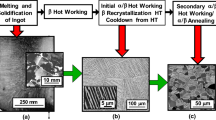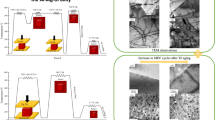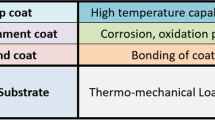Abstract
A new model for predicting the creep behavior of SiC/PyC/SiC mini-composites under wet oxygen atmosphere (900 ~ 1200℃, 1% ~ 50%H2O) is developed based on the thermal–mechanical, environmental-micro, fiber strength degradation, and creep-oxidation model. The model firstly takes the effects of the catalysis of water vapor, the oxidation of matrix and interphase, fiber strength degradation due to the grain growing, thermal decomposition, and growth of silica scale, creep of fibers into account comprehensively. The predicted strain–time curves involving three stages presented for the case of a KD-I/PyC/SiC mini-composites are compared to the experimental data at 900℃ under 1%H2O. The model predictions show that the increase of temperature accelerates the consumption of interphase and the growth of silica scale on the fiber, which promotes the failure of fibers by load transfer and fiber degradation. The increase of water vapor pressures promotes the growth of silica scale on the fiber and matrix, but has little influence on the consumption of interphase due to the effect of inhibition of water vapor on the carbon. The effect of creep and oxidation on the matrix crack spacing is checked by the critical matrix strain energy criterion and the results indicate that the creep and oxidation of the mini-composites have no influence on the matrix crack spacing. The application of the method in this work contributes to the analysis of mechanical behavior and failure mechanism of SiCf/SiC structures, such as turbine guide vane, which may serve in the wet oxygen atmosphere for a long period.







Similar content being viewed by others
References
Ding, D., Zhou, W., Luo, F., Chen, M., Zhu, D.: Mechanical properties and oxidation resistance of SiCf/CVI-SiC composites with PIP-SiC interphase. Ceram. Int. 38, 3929–3934 (2012). https://doi.org/10.1016/j.ceramint.2012.01.045
Chai, Y., Zhou, X., Zhang, H.: Effect of oxidation treatment on KD–II SiC fiber–reinforced SiC composites. Ceram. Int. 43, 9934–9940 (2017). https://doi.org/10.1016/j.ceramint.2017.05.001
Casas, L., Martínez-Esnaola, J.M.: Modelling the effect of oxidation on the creep behaviour of fibre-reinforced ceramic matrix composites. Acta Mater. 51, 3745–3757 (2003). https://doi.org/10.1016/S1359-6454(03)00189-7
Ruggles-Wrenn, M.B., Kurtz, G.: Notch Sensitivity of Fatigue Behavior of a Hi-NicalonTM/SiC-B4C Composite at 1,200 °C in Air and in Steam. Appl. Compos. Mater. 20, 891–905 (2013). https://doi.org/10.1007/s10443-012-9277-4
Morscher, G.N., Cawley, J.D.: Intermediate temperature strength degradationin SiC/SiC composites. J. Eur. Ceram. Soc. 22, 2777–2787 (2002). https://doi.org/10.1016/S0955-2219(02)00144-9
Morscher, G.N., Hurst, J., Brewer, D.: Intermediate-Temperature Stress Rupture of a Woven Hi-Nicalon, BN-Interphase, SiC-Matrix Composite in Air. J. Am. Ceram. Soc. 83, 1441–1449 (2000). https://doi.org/10.1111/j.1151-2916.2000.tb01408.x
Chermant, J.L., Boitier, G., Darzens, S., Farizy, G., Vicens, J., Sangleboeuf, J.C.: The creep mechanism of ceramic matrix composites at low temperature and stress, by a material science approach. J. Eur. Ceram. Soc. 22, 2443–2460 (2002). https://doi.org/10.1016/S0955-2219(02)00103-6
Carrère, P., Lamon, J.: Creep behaviour of a SiC/Si-B-C composite with a self-healing multilayered matrix. J. Eur. Ceram. Soc. 23, 1105–1114 (2003). https://doi.org/10.1016/S0955-2219(02)00273-X
Naslain, R.R., Pailler, R.J.-F., Lamon, J.L.: Single- and Multilayered Interphases in SiC/SiC Composites Exposed to Severe Environmental Conditions: An Overview. Int. J. Appl. Ceram. Technol. 7, 263–275 (2010). https://doi.org/10.1111/j.1744-7402.2009.02424.x
Filipuzzi, L., Naslain, R.: Oxidation Mechanisms and Kinetics of 1D-SiC/C/SiC Composite Materials: II. Modeling. J. Am. Ceram. Soc. 77, 467–480 (1994). https://doi.org/10.1111/j.1151-2916.1994.tb07016.x
Singhal, S.C.: Oxidation kinetics of hot-pressed silicon carbide. J. Mater. Sci. 11, 1246–1253 (1976). https://doi.org/10.1007/BF00545142
Heredia, F.E., McNulty, J.C., Zok, F.W., Evans, A.G.: Oxidation Embrittlement Probe for Ceramic-Matrix Composites. J. Am. Ceram. Soc. 78, 2097–2100 (1995). https://doi.org/10.1111/j.1151-2916.1995.tb08621.x
Evans, A.G., Zok, F.W., McMeeking, R.M., Du, Z.Z.: Models of High-Temperature, Environmentally Assisted Embrittlement in Ceramic-Matrix Composites. J. Am. Ceram. Soc. 79, 2345–2352 (1996). https://doi.org/10.1111/j.1151-2916.1996.tb08982.x
Lara-Curzio, E.: Analysis of oxidation-assisted stress-rupture of continuous fiber-reinforced ceramic matrix composites at intermediate temperatures. Compos. Part A Appl. Sci. Manuf. 30, 549–554 (1999). https://doi.org/10.1016/S1359-835X(98)00148-1
Yu, G., Gao, X., Chen, Y., Song, Y.: Failure Modeling of SiC/SiC Mini-Composites in Air Oxidizing Environments. Appl. Compos. Mater. 25, 1441–1454 (2018). https://doi.org/10.1007/s10443-018-9676-2
Darzens, S., Chermant, J.-L., Vicens, J., Sangleboeuf, J.-C.: Understanding of the creep behavior of SiCf–SiBC composites. Scr. Mater. 47, 433–439 (2002). https://doi.org/10.1016/S1359-6462(02)00114-8
Chen, X., Sun, Z., Li, H., Song, Y., Niu, X.: Modeling the effect of oxidation on the residual tensile strength of SiC/C/SiC minicomposites in stressed oxidizing environments. J. Mater. Sci. 55, 3388–3407 (2020). https://doi.org/10.1007/s10853-019-04255-4
Jorgensen, P.J., Wadsworth, M.E., Cutler, I.B.: Effects of Water Vapor on Oxidation of Silicon Carbide. J. Am. Ceram. Soc. 44, 258–261 (1961). https://doi.org/10.1111/j.1151-2916.1961.tb15374.x
Opila, E.J.: Oxidation Kinetics of Chemically Vapor-Deposited Silicon Carbide in Wet Oxygen. J. Am. Ceram. Soc. 77, 730–736 (1994). https://doi.org/10.1111/j.1151-2916.1994.tb05357.x
Sun, Z., Shao, H., Niu, X., Song, Y.: Simulation of Mechanical Behaviors of Ceramic Composites Under Stress-Oxidation Environment While Considering the Effect of Matrix Cracks. Appl. Compos. Mater. 23, 477–494 (2016). https://doi.org/10.1007/s10443-015-9469-9
Cappelen, H., Johansen, K.H, K.M.: Oxidation of silicon carbide in oxygen and in water vapor at 1500° C. Acta. Chem. Scand. Ser. A. 35, 247–254 (1981). https://doi.org/10.3891/acta.chem.scand.35a-0247
Parthasarathy, T.A., Cox, B., Sudre, O., Przybyla, C., Cinibulk, M.K.: Modeling environmentally induced property degradation of SiC/BN/SiC ceramic matrix composites. J. Am. Ceram. Soc. 101, 973–997 (2018). https://doi.org/10.1111/jace.15325
Opila, E.J.: Variation of the Oxidation Rate of Silicon Carbide with Water-Vapor Pressure. J. Am. Ceram. Soc. 82, 625–636 (1999). https://doi.org/10.1111/j.1151-2916.1999.tb01810.x
Takeda, M., Sakamoto, J., Imai, Y., Ichikawa, H.: Thermal stability of the low-oxygen-content silicon carbide fiber. Hi-NicalonTM. Compos. Sci. Technol. 59, 813–819 (1999). https://doi.org/10.1016/S0266-3538(99)00012-3
Gosset, D., Colin, C., Jankowiak, A., Vandenberghe, T., Lochet, N.: X-ray Diffraction Study of the Effect of High-Temperature Heat Treatment on the Microstructural Stability of Third-Generation SiC Fibers. J. Am. Ceram. Soc. 96, 1622–1628 (2013). https://doi.org/10.1111/jace.12174
Grujicic, M., Galgalikar, R., Snipes, J.S., Ramaswami, S.: Multi-length-scale Material Model for SiC/SiC Ceramic-Matrix Composites (CMCs): Inclusion of In-Service Environmental Effects. J. Mater. Eng. Perform. 25, 199–219 (2016). https://doi.org/10.1007/s11665-015-1850-1
Helmer, T., Peterlik, H., Kromp, K.: Coating of Carbon Fibers—The Strength of the Fibers. J. Am. Ceram. Soc. 78, 133–136 (1995). https://doi.org/10.1111/j.1151-2916.1995.tb08372.x
Ochiai, S., Hojo, M., Tanaka, M.: Mechanical interactions between fiber and cracked coating layer and their influences on fiber strength. Compos. Part A Appl. Sci. Manuf. 30, 451–461 (1999). https://doi.org/10.1016/S1359-835X(98)00134-1
Curtin, W.A.: Theory of Mechanical Properties of Ceramic-Matrix Composites. J. Am. Ceram. Soc. 74, 2837–2845 (1991). https://doi.org/10.1111/j.1151-2916.1991.tb06852.x
Evans, A.G., Weber, C.: Creep damage in SiC/SiC composites. Mater. Sci. Eng. A. 208, 1–6 (1996). https://doi.org/10.1016/0921-5093(95)09867-4
Sha, J.J., Park, J.S., Hinoki, T., Kohyama, A.: Bend stress relaxation of advanced SiC-based fibers and its prediction to tensile creep. Mech. Mater. 39, 175–182 (2007). https://doi.org/10.1016/j.mechmat.2006.04.001
Weibull, W.: A statistical distribution of wide applicability. J. Appl. Mech. 18, 293–297 (1951)
Xiaowei, Y.: Oxiadation Behavior of 3D C/SiC Composites in Oxidizing Environments, (2017)
Terrani, K.A., Pint, B.A., Parish, C.M., Silva, C.M., Snead, L.L., Katoh, Y.: Silicon Carbide Oxidation in Steam up to 2 MPa. J. Am. Ceram. Soc. 97, 2331–2352 (2014). https://doi.org/10.1111/jace.13094
C Yue: Creep Mechanics Behavior and Mesoscopic Mechanics Simulation of CMCs, (2017)
Zhu, S., Mizuno, M., Kagawa, Y., Mutoh, Y.: Monotonic tension, fatigue and creep behavior of SiC-fiber-reinforced SiC-matrix composites: a review. Compos. Sci. Technol. 59, 833–851 (1999). https://doi.org/10.1016/S0266-3538(99)00014-7
Zhang, S., Gao, X., Chen, J., Dong, H., Song, Y.: Strength model of the matrix element in SiC/SiC composites. Mater. Des. 101, 66–71 (2016). https://doi.org/10.1016/j.matdes.2016.03.166
Acknowledgments
This work was supported by the National Basic Research Program of China, the National Natural Science Foundation of China [grant number 51675266]; the Postgraduate Research & Practice Innovation Program of Jiangsu Province [grant number KYCX18_0314]; the Fundamental Research Funds for the Central Universities [grant number NJ20160038]; the Jiangsu Planned Projects for Postdoctoral Research Funds(2019K029) and the Jiangsu Province Key Laboratory of Aerospace Power System [grant number CEPE2019004] are gratefully acknowledged.
Author information
Authors and Affiliations
Corresponding authors
Additional information
Publisher’s Note
Springer Nature remains neutral with regard to jurisdictional claims in published maps and institutional affiliations.
Rights and permissions
About this article
Cite this article
Chen, X., Wu, W., Sun, Z. et al. Modeling the Effect of Oxidation on the Creep Behavior of SiC/PyC/SiC Mini-composites Under Wet Oxygen Atmosphere. Appl Compos Mater 28, 297–319 (2021). https://doi.org/10.1007/s10443-021-09870-6
Received:
Accepted:
Published:
Issue Date:
DOI: https://doi.org/10.1007/s10443-021-09870-6




